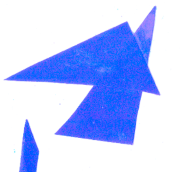a critique/perception or conversation published on ateliê397’s website on november 18th, 2015
unstructure itself. bewilder itself. body and mud mix up together and operate by association. subject-body-environment. not even subject yet: thing. object that ANIMATES. and then, bug. rather, it could be a leaf, a piece of wood, of a tree. while plant, part of the landscape; as a bug, does it prevail? stands out in the whole? the animal does exist, but what would this existence be as a world?
spare are the modes of rest built by a man (male, white, singular) before the EARTH, at what price – a dam comes apart, tumbling down – to erect the plans. numb, arrogant, stiff and straight, in such a way a plant would never be. skyscrapers, or not so high: crawling and sloughs fill out forests and namely infertile lands – by unfortunate actions. buildings, no shelter. colossal membranes.
on a different corner crops up a branch. perhaps it had already been there. either by chance or persistence, it flourishes, then spreads. it ruminates. it grows to the point in which no one knows if it’s animal or plant, subject or landscape. ingenious drawings on the skin of some, a fearless chain of many, it happens. complex organizations prioritize, just like ants and all that observes, a certain operation that endures. unless – to see the ants men poured cement into the grooves of anthills, and then a sculpture of the subterranean megalopolis was formed. suddenly fossilized. a simple genocide in the name of science.
what we have here is produced space. consumed, detailed, created by a minutiae of composition. at first it is dark, barks of trees. a glance inquiring into the details of deep woods, or a simple garden. no green, mostly brown. takes aren’t long, ending before they can be deciphered. perhaps the length of a roll of film, in meters, physical unit of lenght for cellulose, its organic compound, in 16mm. cellulose on the screen, projected – plain fractions of tree, paper. nearly everything composes. nearly everything escapes.
gradually, a merger happens. folded papers share the space with fragments of aged branches and leaves. a once shady background gives room to white. structures are erected in between the species – the branches – and they long for it. this bug will pull on the boundaries of in between things, of what is null, of what is nullified. of what disappears.
at a minimum movement, you see paws. finally, paws! it’s an animal, now. an apparition of oneself – phasmid, phantom’s sister word – steps into in such a way it reminds us of the monk slowly crossing the city in recent tsai ming liang films, such as ‘walker’ (2012) and ‘journey to the west’ (2014). movement, at its least, is enough to identify an action and to distinguish, from that moment on, a character. in the next scene, the same thing happens. is it in there? it turns into a game, in slow pace, episodes.
acrobatic, the disguise of the subtle insect-dancer shapes angles, operates by resemblance even with the geometrical shapes enclosing it, folded papers resemling lygia clark’s constructions: bugs, once again.
would it be important to distinguish between form and form, animal or perfidy? lygia clark herself gives us clues in her notes, especially from ‘walking’ (1964), when seeking a kind of dissolution of existence in the world, in which body is also landscape, crossed and hybridized by animals, frequencies, intensities. “birds and lions inhabit us”, says lygia – “they are our animal-body,” brings suely rolnik. of the supression of object: “the fantasy of the world as a great animal unperceived by man”
daniel steegman mangrané, in an interview with fábio zucker, says that, consciously, didn’t think of lygia clark when he was making the studio environment in which walks the stick insect in phasmides, revealed in the final sequence. however, in a later situation, he created an architectural device that was confronted, in an exhibition, with one of lygia’s bugs and a metaesquema by helio oiticica.
the contrast between architectural works – and their straight lines – and the strong, all-embracing manifestation of what we know by nature, forest, and its inhabitants, appears in much of the artist’s works. an obvious conversation with the legacy of concretism and abstractionism is also there, in which graphisms, metallic constructions and installations contest ways of being and entering places, composing form, assimilating.
in the context of the exhibition ‘o que caminha ao lado’ (something like ‘what walks beside us’), curated by isabella rjeille, PHASMIDES presents itself to the public in a small room next to the institution’ living area. the works of the other artists present in the collective evoke, in distinct manners, images or sounds of ghosts, signs, similar and dissimilar, imitations, figures. the doppelgänger, an old german myth, touches the evidence of the double, or its allusion, so that limits of identity are questioned.
two years after its first apparition, PHASMIDES, in 2015, talks with their double adverses, running children, bugs and other phantoms. body survival in environment, existence in studio, straight lines?
